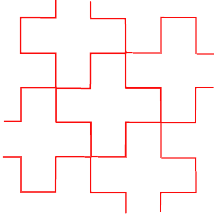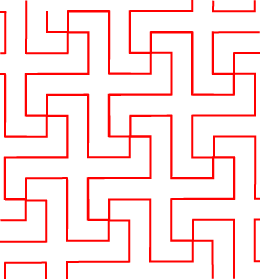|
 A Greek cross is a simple 12-sided polygon which we can think of as the union of 5 congruent squares. Red Greek crosses are shown at right. A Greek cross is a simple 12-sided polygon which we can think of as the union of 5 congruent squares. Red Greek crosses are shown at right.
Problem G1. Find a 4-piece dissection of a Greek cross into a square.
We observe that the Greek crosses nicely tessellate the plane as at right. Now perhaps we might be able to superimpose a tessellation of squares of side length  5 (why this length?). There are some obvious placings for such a tessellation. What are they? Let us try this one. Can you see the solution now? Here it is. You could make a nice 4-piece cardboard puzzle out of this. 5 (why this length?). There are some obvious placings for such a tessellation. What are they? Let us try this one. Can you see the solution now? Here it is. You could make a nice 4-piece cardboard puzzle out of this.
A very simlar problem is:
 Problem G2. Find a 4-piece dissection of a swastika into a square. Problem G2. Find a 4-piece dissection of a swastika into a square.
At left we show part of a tessellation of swastikas. Measured in suitable unit squares, what is the area of a swastika? What is the side length of a square of the same area? What would be a good choice of position for a square of the corresponding square tessellation?
Here is a moveable tessellation of squares – we have chosen the right angle! Drag this tessellation to a suitable position over the swastikas. The area of the swastika is 17 (unit squares), so the side length of a square is  17. Here is a right position,for the square tessellation, and here is the corresponding dissection of swastika into square. 17. Here is a right position,for the square tessellation, and here is the corresponding dissection of swastika into square.
This puzzle comes from The Mathematical Puzzles of Sam Loyd Vol 2 (Dover 1960).
If you are interested in checking out dissections of Greek crosses to various other polygons, see Gavin Theobald’s site.
|
 A Greek cross is a simple 12-sided polygon which we can think of as the union of 5 congruent squares. Red Greek crosses are shown at right.
A Greek cross is a simple 12-sided polygon which we can think of as the union of 5 congruent squares. Red Greek crosses are shown at right. Problem G2. Find a 4-piece dissection of a swastika into a square.
Problem G2. Find a 4-piece dissection of a swastika into a square.